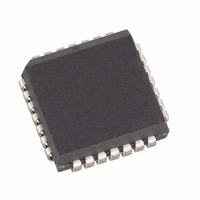DS2165QN+ Maxim Integrated Products, DS2165QN+ Datasheet - Page 2

DS2165QN+
Manufacturer Part Number
DS2165QN+
Description
IC PROC ADPCM 16/24/32K 28-PLCC
Manufacturer
Maxim Integrated Products
Type
ADPCM Processorr
Datasheet
1.DS2165Q.pdf
(17 pages)
Specifications of DS2165QN+
Mounting Type
Surface Mount
Package / Case
28-LCC, 28-PLCC
Lead Free Status / RoHS Status
Lead free / RoHS Compliant
Applications
-
DS2165Q
OVERVIEW
The DS2165Q contains three major functional blocks: a high performance (10 MIPS) DSP engine, two
independent PCM interfaces (X and Y) that connect directly to serial time-division-multiplexed (TDM)
backplanes, and a serial port that can configure the device on-the-fly by an external controller. A 10MHz
master clock is required by the DSP engine. The DS2165Q can be configured to perform either two
expansions, two compressions, or one expansion and one compression. The PCM/ADPCM data interfaces
support data rates from 256kHz to 4.096MHz. Typically, the PCM data rates are 1.544MHz for m-law and
2.048MHz for A-law. Each channel on the device samples the serial input PCM or ADPCM bit stream
during a user-programmed input time slot, processes the data and outputs the result during a user-
programmed output time slot.
Each PCM interface has a control register that specifies functional characteristics (compress, expand,
bypass, and idle), data format (m-law or A-law), and algorithm reset control. With the SPS pin strapped
high, the software mode is enabled and the serial port can be used to configure the device. In this mode, a
novel addressing scheme allows multiple devices to share a common 3-wire control bus, simplifying
system-level interconnect.
With SPS low, the hardware mode is enabled. This mode disables the serial port and maps certain control
register bits to some of the address and serial port pins. Under the hardware mode, no external host
controller is required and all PCM/ADPCM input and output time slots default to time slot 0.
HARDWARE RESET
allows the user to reset both channel algorithms and the contents of the internal registers. This pin
RST
must be held low for at least 1ms on system power-up after the master clock is stable to ensure that the
device has initialized properly.
should also be asserted when changing to or from the hardware
RST
mode.
clears all bits of the control register for both channels except the IPD bits; the IPD bits for
RST
both channels are set to 1.
SOFTWARE MODE
Connecting SPS high enables the software mode. In this mode, an external host controller writes
configuration data to the DS2165Q by the serial port through inputs SCLK, SDI, and
(Figure 2). Each
CS
write to the DS2165Q is either a 2-byte write or a 4-byte write. A 2-byte write consists of the
address/command byte (ACB), followed by a byte to configure the control register (CR) for either the X
or Y channel. The 4-byte write consists of the ACB, followed by a byte to configure the CR, and then 1
byte to set the input time slot and another byte to set the output time slot.
ADDRESS/COMMAND BYTE
In the software mode, the address/command byte is the first byte written to the serial port; it identifies
which of the 64 possible ADPCM processors sharing the port wiring is to be updated. Address data must
match that at inputs A0 to A5. If no match occurs, the device ignores the following configuration data. If
an address match occurs, the next 3 bytes written are accepted as control, input and output time slot data.
Bit ACB.6 determines which side (X or Y) of the device is to be updated. The PCM and ADPCM outputs
are tri-stated during register updates.
2 of 17












